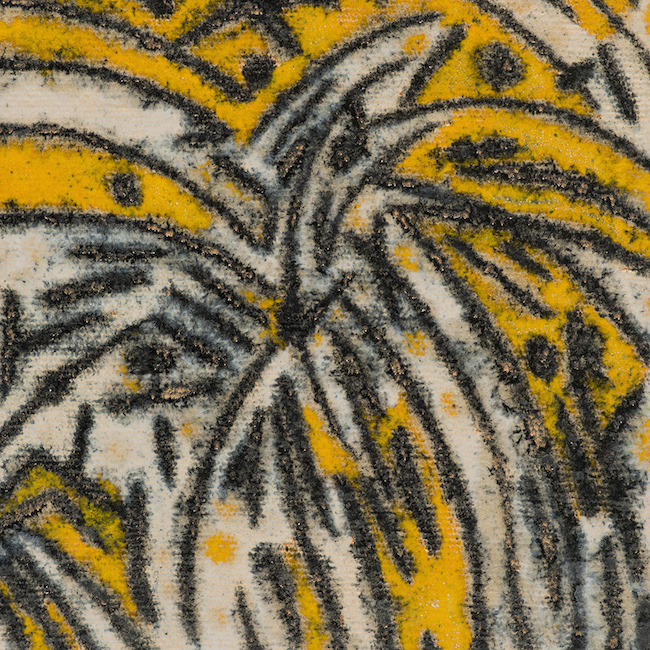Equitable Vitrines, a gallery space in an iconic Los Angeles skyscraper, recently paid tribute to Lee Mullican, a California abstract painter whose works often drifted into sculpture and who was known for his fascination with ancient mark-making techniques. Shatter Special (Los Angeles, October 3, 2015 — November 21, 2015) spanned the postwar artist’s career, with works including ceramics, photography, and computer drawings.

Lee Mullican, Untitled, fire glazed ceramic, 10 1/2 x 8 1/4 x 1/2 inches. Click to see a larger image.
The focal point of the exhibition was mostly Mullican’s ceramic works, produced in Ailes Gilmour’s studio in Croton Falls in the 1960s and in Mullican’s Taos, New Mexico home from the 1970s to the 1990s. Admirers of techy art had a lot to take in with the artist’s computer drawings, which were produced on an old IBM 5170 PC at UCLA in the mid-1980s, according to the gallery. The show was rounded out with abstract photographs taken in Point Lobos and a group of Mullican’s structural photographic experiments. In all, the show was a testament to the vast expanse of Lee Mullican art.

Lee Mullican, Untitled, 1984-1986, fire glazed ceramic and steel, 21 3/4 x 50 x 1/8 inches. Click to see a larger image.
Mullican, born in 1919, was introduced to art by his mother, Zula, who allowed her son to experiment with her paints when he was 15. After attending the University of Oklahoma, he built an off-campus studio then briefly attended the Kansas City Art Institute. Drafted into the US Army Corps of Engineers in 1941, he used his spare time there to develop his work. In 1946 he was invited to San Francisco by a fellow painter. There, he formed a collaborative relationship with British surrealist Gordon Onslow Ford and Wolfgang Paalen. Mullican married Luchita Hurtado in 1954 after the couple had a son and moved to Los Angeles. He worked for most of his life in the Los Angeles area, holding a teaching position at UCLA. He died July 8, 1998.
Mullican is known primarily for his paintings. Writing for the Los Angeles Times, David Pagel described Mullican’s heavily textured, tribal influenced abstractions:
“In a sense, Mullican painted as if he were making crude prints or constructing exceptionally compressed sculptures. However you think of his patiently made abstractions, they are alive with the same visual energy that crackles throughout his influential oeuvre, as fresh as the day they were made and more sophisticated than their materials — and process— suggest.”

(Left) Lee Mullican, Untitled, 1985, fire glazed ceramic, 25 1/4 x 10 1/2 x 6 3/4 inches. (Right) Lee Mullican, Untitled, 1985, fire glazed ceramic, 29 3/4 x 5 3/4 x 8 inches.

(Left) Lee Mullican, Untitled, fire glazed ceramic, 12 1/2 x 9 1/4 x 1/4 inches. (Right) Lee Mullican, Untitled, fire glazed ceramic, 13 1/2 x 6 1/2 x 3/4 inches. Click to see a larger image.
The above quote gives us a good stepping off point to talk about Mullican’s ceramic art. Art Talk, a radio show on KCRW, states that many of Mullican’s ceramics were discovered by the artist’s widow and sons as they explored his old studios and storage spaces in L.A. and Taos. Mullican dabbled in clay after meeting Isamu Noguchi and his sister Ailes Gilmour in the 1950s. During that period he made unglazed red clay works that were inspired by pre-Columbian sculpture and masks he had seen in Mexico and in museums. He picked up clay again in the 1980s while working with a kiln in Taos.
We’re showcasing many of the exhibition’s works in this post. Take a moment to familiarize yourself with this rarely seen branch of Lee Mullican art.
What do you think of Lee Mullican’s explorations in ceramics and computer drawings? Let us know in the comments.

Lee Mullican “Shattered Special” installation view at Equitable Vitrines. Click to see a larger image.

Lee Mullican, Untitled, fire glazed ceramic, 14 1/4 x 18 3/4 x 2 inches. Click to see a larger image.

Lee Mullican, Untitled, ca. 1982; hard drive, projector, reverse projection screen; variable dimensions

(Left) Lee Mullican, Untitled, 1995, fire glazed ceramic, 16 3/4 x 9 1/2 x 1/4 inches. (Right) Lee Mullican, Untitled, 1995, fire glazed ceramic, 17 1/2 x 9 3/4 x 1/4 inches

Lee Mullican, Untitled, 1960, terracotta, 24 x 40 x 1/2 inches overall. Click to see a larger image.







This work is very moving to me. But I wonder, what do they mean by “fire glazed ceramic”?